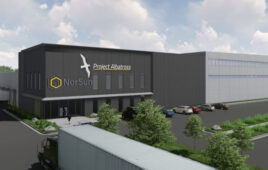 Enphase Energy has announced the launch of its new IQ8 Commercial Microinverters, featuring the IQ8P-3P Microinverter, for the small commercial solar market in North America. The IQ8P-3P Microinverter enables a peak output power of up to 480 W, supporting small three-phase commercial applications and newer, high-powered solar panels.
Enphase Energy has announced the launch of its new IQ8 Commercial Microinverters, featuring the IQ8P-3P Microinverter, for the small commercial solar market in North America. The IQ8P-3P Microinverter enables a peak output power of up to 480 W, supporting small three-phase commercial applications and newer, high-powered solar panels.
The IQ8 Commercial Microinverters are built to support the small commercial solar industry by simplifying the design and installation process, improving energy harvest with higher uptime, expanding system monitoring capabilities compared to similar solutions, and offering industry-leading safety through an AC-based system using low-voltage power. The new microinverters are compatible with a wide range of solar panels including 54, 60, 66, 72 and 144 cell panels with full or split cell, and with a range of 320 W to 640 W, making the products viable to support projects now and in the future.
“We have been installing Enphase products for more than 13 years,” said Jason Szumlansky, owner of Florida Solar Design Group. “Enphase commercial microinverters are a game changer — simplifying installation, improving energy harvest, and satisfying client requirements. Our first project was successful and we found that commissioning a new Enphase commercial system is as simple as commissioning a residential installation.”
The distributed architecture of the Enphase system makes designing projects more seamless by reducing complexity and enabling an optimized panel layout for maximum energy harvesting on crowded or shaded small commercial rooftops. The high-quality manufacturing process and low failure rates unlock a 25-year warranty for all IQ8 Microinverters activated in the United States and Canada, and a 12-year warranty for products activated in Mexico.
The commercial Enphase Energy System also includes the new IQ Gateway Commercial 2, which can be connected to the internet to enable over-the-air updates and connect to the Enphase App monitoring platform. The IQ Gateway Commercial 2 and IQ Microinverters make per-panel energy monitoring and insights for operations and maintenance simple for businesses, asset managers, and installers, including Fleet View for portfolio monitoring and management. Enphase Kiosk Software is provided to display system performance in real-time, offering marketing, brand value and sustainability-tracking by showcasing on-site clean energy generation. The new microinverters also feature Enphase Burst Mode technology, allowing panels to start earlier and turn off later in the day where other systems would stop generating power.
Distributors in the United States, Canada and Mexico can order IQ8 Commercial Microinverters today, with production shipments expected to begin by the end of this year. Shipments are expected to begin from Enphase’s U.S. contract manufacturing facilities in the first quarter of 2024.
News item from Enphase Energy





I have a solar system connected to my house and the end phase system hasn’t worked for two months and I have tried to get endphase to come and fix it but nothing has happened. I have phoned numerous times and have promises that someone will be sent but I haven’t seen anyone yet. I am beginning to think solar is a waste of time and money. I have lost two months of productivity. What a waste. Allan
Maybe you should contact the installer of your solar
I have Sunpower who uses Enphase micro inverters. When I have a problem, I call Sunpower not Enphase. Who is your installer?
I work as a Solar Installer Supervisor/Trainer @ Grid Alternatives. I’ve been in the industry for more than 12 years an I witness the evolution of Enphase products, i remember working with micros 250, etc….. And the service calls for Enphase products are minimum… And when I reach out the team to exchange one old micro they respond really quickly, I’m looking forward to working with this new micros for commercial projects.
I am a electrician in Massachusetts and been doing it for 32 years I like the endphase product fir a numder of reasons? The inverter equipment is located at the panel versus 1 big one on the side of the building and looking hideous? What is more important is that if you have a failure of a inverter it only affects the one panel production? But the one larger unit failure you lose all the possible production of solar until final repair is made. Another factor is the termination out in the field will not fail unlike the string systems that are out there ? Because the D rating factors for a voltage drop and temperature are not done right in the field.
The connections at the pins are not rated 90° ? But the wire is But because the terminal are not rated that’s why they have a higher failure rate versus the endphase product? Many installers are cookie copy type teaching instead of looking outside of the Box.
If the endphase loads are installed at 50% of the wire capabilities plus the connections are to be the main calculation factors you will have no failures.
I could get into more specifics but it be more of my time.
Every one should only use endphase style installation and I believe it will. once everyone learns after all the problems they deal with.